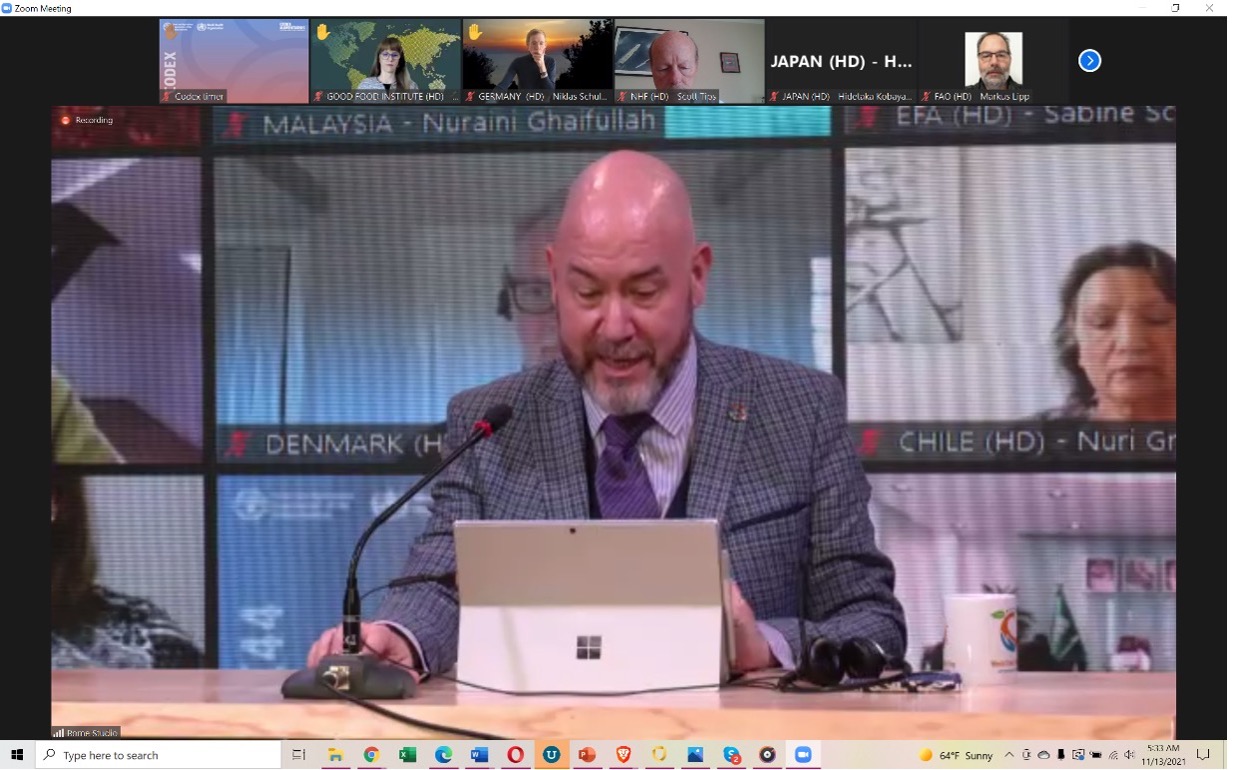Note: The views and opinions expressed here are those of the author(s) and contributor(s) and do not necessarily reflect those of the publisher and editors of WholeFoods Magazine.
No one at the Codex Alimentarius Commission is as nice as the outgoing Chairman Guillermo da Costa, Jr. Even when he is kicking your feet out from under you by not allowing your spoken comments to go into the Final Report of the meeting, he is gentlemanly about it, even charming. He also is one of the most accommodating chairmen or -women when it comes to allowing a delegate to speak—just keep in mind that you will be limited to two minutes and most likely your comments will never make it into the report. For that very reason, this article—not Codex’s carefully scripted Final Report—will give you the more complete story of what happened at a recent meeting on the two key issues confronting the National Health Federation (NHF).
At this Codex meeting—the 44thsession of the Codex Alimentarius Commission, held virtually for the second time—there were as many as 683 attendees “zooming in” from around the World at one time. Typically held for three-hour-long sessions on November 8-13, 15, 17, and 19, 2021, this two-week-long Codex meeting discussed many food and feed issues; but the two main issues for NHF here were the toxic herbicide glyphosate and the animal growth-promoter zilpaterol.
Glyphosate Standards
The extremely toxic herbicide glyphosate is the bête noir of the health and health-freedom movements. NHF has consistently opposed its use in agricultural and other practices at every meeting where NHF has been present and standards permitting the use of glyphosate have been discussed and adopted. Almost always, NHF has been the lone voice in opposition.On the second day of the CAC meeting, the various pesticide standards created by the Codex Committee on Pesticide Residues were discussed. When NHF was called upon to speak, I stated NHF’s objection to glyphosate: “NHF expresses its continued objection to the use of glyphosate in any form for the reasons given in our CRD37 [Conference Room Document 37], that is, that glyphosate, among other things, is a major contributor to Anti-Microbial Resistance worldwide.” (SeeNHF’s CRD 37); “Emergence of resistance in bacteria and fungi is correlated with glyphosate use in the World over the last 40 years.”)
In 11 minutes, from start to finish, the Chairman disposed of the glyphosate standards up for consideration, either adopting the standards or else advancing them up the eight-step ladder depending upon where they were in the process, and then moved on to the next agenda topic. NHF’s objections were quickly forgotten by most, but not all, of the delegates. With anti-microbial resistance on the rise worldwide, and with public-health authorities everywhere searching for measures to curb it, NHF had sown the seeds of truth, showing that glyphosate is a major culprit in this growing problem.
It is hugely ironic, though, that on the one hand Codex Alimentarius is fighting antimicrobial resistance while at the same time adopting numerous standards permitting glyphosate usage around the World that lead to antimicrobial resistance! The people of the World need antimicrobials much more than they need toxic glyphosate; the time has long since arrived to prohibit all glyphosate use worldwide.
Antimicrobial Code of Practice
When the separate agenda item on antimicrobial resistance was discussed the following morning (November 10th), the Commission was poised on the point of adopting the Antimicrobial “Code of Practice” at the final Step 8 to address the growing problem of antibiotic resistance. Per Codex, a Code of Practice (“CoP”) defines “the production, processing, manufacturing, transport and storage practices for individual foods or groups of foods that are considered essential to ensure the safety and suitability of food for consumption.”The European Union (EU) delegate was the first to speak and he expressed the EU’s support for the CoP but urged the Commission to give it a higher level of urgency while eliminating all growth-hormone antimicrobials immediately. The Russian delegate—the ever outspoken and well-spoken Anna Koroleva—supported the EU position and even went further. In Russia’s view, she argued, certain principles in the CoP “allowed critically important antimicrobial agents to be used routinely for control and prevention of diseases and therefore could lead to misuse of such agents for purposes other than treatment” and, therefore, Russia could not fully support the CoP. Norway and a smattering of other countries agreed, as did NHF, in stating its support of Russia’s position.
NHF had already spoken out on the key role of glyphosate in fostering antibiotic resistance worldwide. Now, it was my opportunity to give the delegates yet one more reason to turn their backs on the toxic vet drug zilpaterol, and I took it. “As a catecholamine,” I also told the other delegates, “Zilpaterol has been implicated as a contributory cause for increased bacterial problems coming off commercial feedlots.”
Regardless, the Commission adopted the Code of Practice at Step 8 and dissolved the Ad Hoc Intergovernmental Task Force on Antimicrobial Resistance. But not without a last-minute appeal by CropLife—the Monsanto front group at Codex—which evidently had felt so threatened by NHF’s earlier anti-glyphosate comments, both written and oral, that CropLife asked for permission to file its own written, responsive comments after the deadline for written comments had passed. This was an extraordinary request; but NHF did not object (as CropLife would have done had the roles been reversed), permission was granted, and CropLife did file its own Conference Room Document on glyphosate.
In parting, CropLife made a comment to the Commission delegates that was less than honest. “Glyphosate,” its spokesman said, “is not an antimicrobial or an antibiotic.” Quickly given the floor by the Chairman, I then asked CropLife, “Then why does Monsanto have a patent for glyphosate’s use as an antimicrobial?” [U.S. Patent No. 7,771,736 B2]
Zilpaterol Standards
The Zilpaterol debate at this meeting was just as passionate and lengthy as the one held at the Codex Committee on Residues of Veterinary Drugs in Foods (CCRVDF) virtual meeting held in mid-July 2021, where the EU, Russia, China, Norway, Switzerland, and NHF were able to stop the Zilpaterol standard dead in its tracks. (See my article“CODEX ALIMENTARIUS: One Victory, One Loss—NHF Helps Stop Vet Drug from Flooding the World, But Stands Alone against Glyphosate.") The CCRVDF, as a subsidiary committee, then referred the matter up the chain to CAC44.Unsurprisingly, the Codex Commission was reluctant to tackle the Gordian knot of the Zilpaterol agenda item upfront, so it pushed back that discussion, and, even then, chopped up the discussion into distinct segments. The Zilpaterol discussion began on November 10thand finished on November 17th—kind of. That discussion will never be “over.”
For those unfamiliar with it, Zilpaterol is Merck’s special steroid-like veterinary drug for cattle, pigs, and poultry that unnaturally pushes them to make more muscle and less fat. It harms animals who get it, and it harms some of the humans who eat them. There is no therapeutic benefit whatsoever to the poor animals, only financial benefit to the farmers and vet-drug companies. And, yet, you should have seen some of the fierce emotions on display at this Codex meeting when country proponents of Zilpaterol pleaded with the Commission to push the Codex standard just one step further up the 8-step approval process at Codex so that Merck and others could make more dollars around the World. With such passion, you would have thought they were trying to save lives; but, no, it was only about the money.
Chairman da Costa’s sympathies on this topic were apparent for all to see, as the discussion spider-webbed out in a predictable pattern to entrap nearly all countries into asking for the floor so that they could give their opinions, for or against. For those countries in favor of adopting a Zilpaterol standard, da Costa just thanked the delegate; but for those opposed, he felt compelled nearly every single time to offer his own opinion as to why they were wrong. Tellingly, the Codex head table was having trouble handling the fierce opposition it encountered, as evidenced by the many “five-minute” breaks that it had to take during the discussions.
The European Union, Norway, Switzerland, Russia, China, Kazakhstan, Turkey, Iran, Thailand, and NHF all spoke up strongly against Zilpaterol and its use in animal husbandry. The EU was admirably stubborn in its opposition, while Norway, the Netherlands, and Russia especially gave strong arguments against any advancement towards adoption of a Zilpaterol standard, arguing, in part, that there was no consensus.
But when NHF had its turn to speak at long last, I was the only one to actually define consensus for the Commission: “The absence of sustained opposition.” And NHF reminded the delegates that there was, in fact, sustained opposition and therefore no consensus, and therefore no advancement was possible, not even through a false claim of “scientific consensus.”
Moreover, I told the delegates that “the Codex Procedural Manual very clearly states that: “Risk assessment should be based on realistic exposure scenarios” As stated in Section IV, Risk Analysis, 2(e). This means that one or more risk assessments should have been done on Zilpaterol’s synergistic effects with the other drugs, toxins, endocrine disruptors, hormones, and chemicals that animals and humans are directly exposed to in the real world. This was not done. So, no one can say that the risk assessment conducted on Zilpaterol was complete and robust.”
With only two minutes allotted at a time for each delegation to speak, I was pressed to make all of my arguments, but I did refer the delegates to NHF’sextensive written comments at CRD 43. NHF reminded the delegates that they were the Risk Managers here and, as such, could accept or reject any risk assessment presented to them.
The Australians and a number of other delegates were in dreamland as they continued to argue that “clear consensus” existed, or that “scientific consensus” had been achieved and that was all that counted. These delegates had lost all sense of reality, as even the Chairman struggled with the obvious lack of consensus and the newly minted term “scientific consensus” isn’t even a concept mentioned once in the Codex Procedural Manual. Some delegates, including the United States, mumbled threats about forcing a vote on the issue.
The Chairman—and the Codex Executive Committee—clearly had their own plans for the Zilpaterol standard, and that was to ignore the lack of consensus and advance the standard up one step towards completion as a “compromise.” Several days of this biased conduct, coupled with the Chairman’s repeated attempts to force his written conclusions on the Codex delegates, continued until I could not stand it anymore, and with no one else saying anything about it, I asked for the floor and told the some 600 participants that “One of the things that we at NHF admired so much about the CCRVDF Chairman was that he never let his personal views interfere with his role as an impartial chairman. We had hoped that that tradition would be carried on here. But it hasn’t been, and you Mr. Chairman seem to have an agenda. It’s hard to say these things because you are a genuinely nice man, but I don’t think you are hearing the substantial opposition to these MRLs [Maximum Residue Levels]. We don’t see any flexibility on your part here and it is no compromise to advance this standard.”
In the end, and after three attempts to pressure the pro-health (anti-Zilpaterol) delegates into accepting his “compromise,” the Chairman and the head table had the weekend to read and digest the newly submitted written comments (including NHF’s CRD 43). The verbal opposition combined with the opposition’s new, written submissions must have had their intended effect because the Chairman gave up his push for the Zilpaterol standard to advance to Step 5. In remarks made on Monday, November 15th, the Chairman even gave an unsolicited compliment to NHF by stating that he had read and considered NHF’s CRD 43. The final Conclusion adopted at the meeting was still biased in favor of the standard, but at least it generally reflected the reality of the multi-day discussion at the meeting.
At the last minute, the Merck front group misleadingly named “Health for Animals” tried to insert language into the all-important Conclusion incorrectly stating that “all procedural requirements for advancement had been met”; but as quickly as a game-show contestant, I hit the “buzzer” and NHF was given the floor immediately after the wording was inserted in the on-screen text. In less than one minute I was able to knock that wording out of the text by pointing out that it was an untrue statement in that the Zilpaterol standard had not met all of the procedural requirements or else we would not be at this impasse and unable to advance the standard.
In the end, the Zilpaterol standard did not advance even one step. This is at least the third time that NHF and its allies have defeated Merck and its naïve or bought-and-paid-for Zilpaterol supporters at Codex, but it was a very close victory.
Still, as Winston Churchill famously quipped, “Victory is never final.” The United States and some of its Codex allies have threatened to call for a vote on the Zilpaterol standard and I am certain they will do just that at the next CAC meeting. In the end, this maneuver could prove as divisive and disruptive to the Codex Alimentarius Commission as the forced vote on the similar vet drug Ractopamine in July 2012.
Russia to the Rescue
On November 17th, the Commission “read the Report,” which means that the wording for the minutes of the meeting were carefully considered by all and agreed upon. NHF had made two comments that should have been in the Final Report, but which were specifically excluded by the Chairman and the now not-so-friendly Codex Secretariat. NHF had mentioned on two separate occasions the antimicrobial-resistance problems caused by the use of glyphosate and zilpaterol, respectively. In the former instance, my arguments for its inclusion fell on the deaf ears of the head table, despite the kind assisting arguments made by fellow INGO the European Network of Childbirth Associations (ENCA). And in the second instance, the Russian Federation delegate Anna Koroleva intervened on behalf of NHF to visit her formidable wrath on the head table for refusing to place NHF’s comments on Zilpaterol into the Report. Both interventions on our behalf were much appreciated by NHF, but unfortunately ultimately proved fruitless in the face of the intransigent Chairman.NHF’s comments were not the only ones deliberately omitted from the Final Report by the Chairman and Codex Secretariat. Important comments made during the meeting by ENCA and the International Baby Formula Action Network (IBFAN) were refused as well. And, similarly, even Russia, a Codex member state, had no luck inserting into the Report “its concern that Zilpaterol posed a health risk to humans due to the huge risk for functional disorders and diseases of the cardiovascular system, and noting that according to their studies the results of JECFA risk assessment did not take into account vulnerable groups of people and people that have cardiovascular disease.”

With a new CAC Chairman—Mr. Steve Wearne of the UK—having been elected, it remains to be seen if the Commission will continue to pursue its “industry can do no wrong” approach or will consider consumer interests and concerns. Apparently, the Codex Secretariat has adopted a pro-industry approach that does not bode well for the future.
However, after the end of three weeks of truly grueling back-to-back Codex meetings in November 2021 (two weeks for the Codex Alimentarius Commission (CAC) meeting and one week for the Codex Nutrition Committee (CCNFSDU) meeting), I am greatly encouraged by the pro-health and pro-consumer views of the Russian delegation, whose views on the issues important to NHF largely mirror our own. Couple those views with an outspoken spokeswoman who speaks excellent English and is not afraid to speak up when necessary, and this is a positive development for consumers. In fact, at one point during the meeting, I told the Russian delegate, Anna Koroleva, that I felt she spoke out at Codex more for the interests of the American consumer than did the U.S. delegate! And indeed, she did.WF










